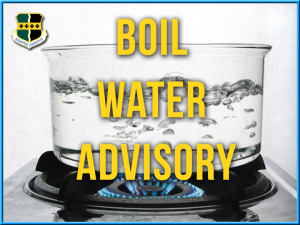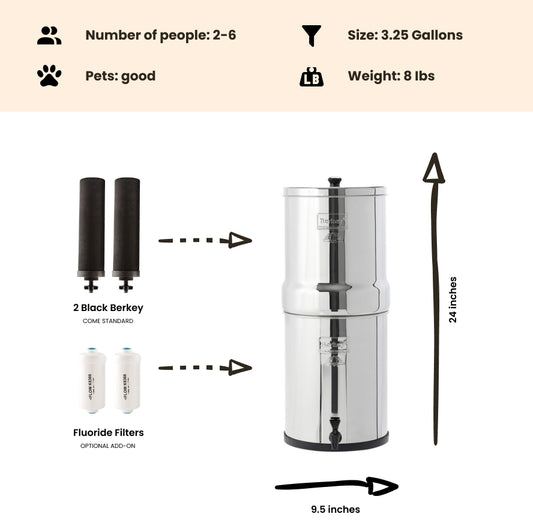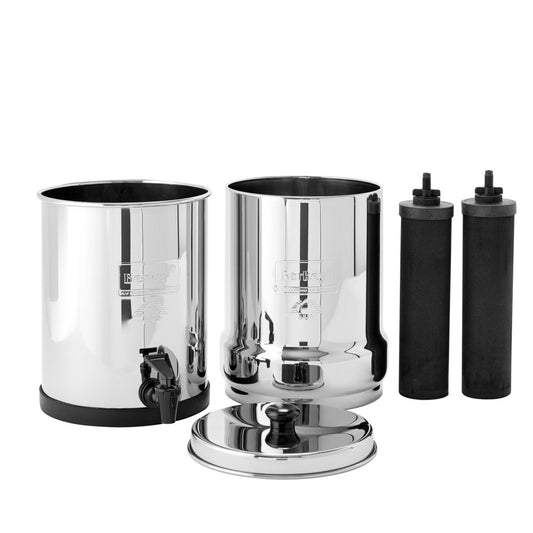
What to Do When a Boil Water Advisory is Issued
By Dan DeBaunShare
In the event that a water supply line or any other part of a city's water distribution network is damaged, a boil water advisory may be issued as a precautionary measure to protect consumers from any potential contamination. Boil water advisories may be caused by severe weather events such as hurricanes and floods, broken water pipes, chemical spills, or due to contamination of the water supply by pathogenic microorganisms. Boil water advisories are also issued if the water pressure in the distribution network falls below 20psi, since low water pressure makes it easy for bacteria to enter the water pipeline.
Should a boil water advisory be issued, it is essential that you do not drink water straight from the tap without either filtering with a berkey water filter or boiling / disinfecting it first to kill off any pathogenic microorganisms that may be present.
Pathogens that Could Potentially Pose a Risk
When the main water supply lines suffer damage, disease causing contaminants such as E. coli, Cryptosporidium, Giardia, and other bacteria and viruses can enter the water supply, posing a health risk to anyone exposed to them. While these pathogens are not likely to be life-threatening, they can make you and your family very ill. Vulnerable members of the population include young children, the elderly and people who's immune systems are already compromised. These pathogenic microorganisms typically affect gastrointestinal health, causing symptoms such as stomach cramps, diarrhea, nausea and vomiting, and possibly also a fever. By boiling the water, the temperature at boiling point will kill any bacteria that may have found its way into your water, protecting your family from potential harm.
Boiling Water to Kill Pathogens
When a boil water advisory is issued you should heat up drinking water until it starts to boil, then let it continue boiling for at least one minute. If you live in a high altitude area (above 6,562 feet), you should let the water continue boiling for three minutes after it has reached a full rolling boil to ensure any pathogens that may be present are killed. Turn off the heat and leave the water to stand so that it can cool down naturally. Once it is cool, you can store it in clean, sealed containers to use as required. While boiling water is an effective way to remove pathogenic microorganisms from water, it is not effective at removing other contaminants such as chemicals and heavy metals that are commonly found in drinking water.
Can I Filter my Water Instead of Boiling it?
When a boil water advisory is issued, it is recommended that you boil your water even if you use a water filter to remove contaminants. The reason being that the majority of home water filters are not effective at treating water contaminated with tiny pathogenic microorganisms as most of the filters on the market do not remove or kill pathogens.
Having said that, top quality drinking water filters like the Big Berkey range of home water filters that are fitted with sub-micron filters, pack a lot more punch. Big Berkey water filters are capable of removing pathogenic bacteria, viruses and parasites to greater than 99.9999%, and can also remove heavy metals, chemicals and many other common drinking water contaminants at the same time. Unless your water filter is certified for removing bacteria, viruses and parasites, you are still at risk and will need to boil water during a boil water advisory. The same goes for water or ice dispensed from a fridge or ice maker with an inbuilt filter. To be safe rather use boiled water to make ice, or water that has been filtered with a suitable high quality drinking water filter capable of removing any bacteria, viruses and parasites that may be present during the boil water advisory. If you use a water filter during a boil water advisory, it is good practice to replace the filter cartridges in your water filter when the boil water advisory ends, as they may have become contaminated with pathogens removed from the contaminated water as it passed through the filter/s.
Other types of water filtration systems, such as an optimally functioning reverse osmosis system fitted with appropriate filters are also effective an limiting exposure to pathogenic microoganisms during a boil water advisory. However if the advisory persists for more than a day, you should replace the membrane as it may become less effective as contaminants accumulate.
A UV water purification system is the one of the most effective ways of eradicating the threat posed by pathogens present in contaminated water. The ultraviolet light disrupts the microorganisms genetic material, preventing them from reproducing or functioning effectively, rendering them harmless.
How do I Treat Water if the Power Goes Off?
If you do not have power during a boil water advisory you will need to disinfect the water instead. You can keep a supply of water disinfectant tablets on hand in preparation for emergencies, or if you don't have these available, you can use unscented household bleach. Bleach contains chlorine, the ingredient water utilities use to disinfect drinking water supplies at the treatment plant. Add about an eighth of a teaspoon of bleach to a gallon of water, then stir and leave it to stand for half an hour. Repeat this process if the water is cloudy after standing for 30 minutes. The bleach may make the water smell like chlorine, but it will be safe to drink.
Preparing Food During a Boil Water Advisory
To be safe, it is best to was all fresh produce with water that has been boiled, effectively filtered or disinfected, or alternatively use bottled water to wash fruit and veggies. Water used for cooking should first be boiled at a full rolling boil for at least a minute or filtered with an appropriate water filtration system before adding food. When using a coffee machine to make coffee first boil the water and let it cool before adding it to the machine to make coffee.
Preparing Baby Formula During a Boil Water Advisory
When preparing baby formula try to use bottled water wherever possible. If you don't have an adequate filter or bottled water available, use boiled water that has been brought to a rolling boil for at least two minutes. Allow the water to cool before using it to prepare the formula. Ensure that all baby bottles, teats and rings have been sterilized in boiling water for two minutes or longer before use. Infants are very vulnerable to illness caused by exposure to pathogens as their immune systems are undeveloped. Take precautionary measures to prevent your baby from ingesting potentially contaminated tap water if a boil water advisory has been issued.
Can I Wash Dishes During a Boil Water Advisory?
If you do your dishes by hand, you can add unscented bleach to your dishwater to disinfect it (1 tablespoon bleach per gallon of water). Leave your dishes to soak for at least one minute before rinsing in clean boiled water. If you have a dishwasher that has a hot wash that reaches a temperature of 170° Fahrenheit or more, it is safe to use for dishwashing during a boil water advisory as these high temperatures will kill any pathogens. Many dishwashers operate at cooler temperatures and are therefore not safe to use during a boil water advisory, in which case you should wash dishes by hand using bleach to disinfect the water.
Showering During a Boil Water Advisory
While it is perfectly safe to take a shower or enjoy a hot bath during a boil water advisory, you must ensure that you do not swallow contaminated water while washing. It is safer to bathe children with a sponge to reduce the risk of them swallowing water while washing. You can also used boiled water that has been left to cool down or water that has been disinfected to bathe babies in, or to be safe, you can even use bottled water. People who have open wounds and those suffering from any chronic illness should use boiled water for bathing to minimize the risk of infection.
Brushing Teeth During a Boil Water Advisory
To avoid the risk of swallowing contaminated water, only use bottled water or water that has been filtered, boiled or disinfected for brushing teeth. Swallowing just a little bit of contaminated water can endanger your health — rather take precautions to prevent it.
Protecting Pets During a Boil Water Advisory
Pets are also susceptible to diseases caused by waterborne pathogens, and therefore need to be protected during a boil water advisory. Only provide your pet with bottled water or water that has been adequately filtered, disinfected, or boiled beforehand. Boiled water should be allowed to cool sufficiently before putting down for your pet to drink.
By taking these precautionary measures to ensure your family and pets are not exposed to contaminated water during a boil water advisory, you will protect them from potentially harmful pathogens that may be present in the water.
-
Regular price $234.00 USDRegular priceUnit price / per
-
Regular price $327.00 USDRegular priceUnit price / per
-
Regular price From $367.00 USDRegular priceUnit price / per
-
Regular price From $408.00 USDRegular priceUnit price / per
-
Regular price From $451.00 USDRegular priceUnit price / per
-
Regular price From $478.00 USDRegular priceUnit price / per
-
Regular price $332.50 USDRegular priceUnit price / per
$350.00 USDSale price $332.50 USDSale

Dan DeBaun
Dan DeBaun is the owner and operator of Big Berkey Water Filters. Prior to Berkey, Dan was an asset manager for a major telecommunications company. He graduated from Rutgers with an undergraduate degree in industrial engineering, followed by an MBA in finance from Rutgers as well. Dan enjoys biohacking, exercising, meditation, beach life, and spending time with family and friends.
~ The Owner of Big Berkey Water Filters

















You say (I added emphasis):
Big Berkey water filters ARE CAPABLE of removing pathogenic bacteria, viruses and parasites to greater than 99.9999%, and can also remove heavy metals, chemicals and many other common drinking water contaminants at the same time. Unless your water filter IS CERTIFIED for removing bacteria, viruses and parasites, you are still at risk and will need to boil water during a boil water advisory.
Can you clarify... does "are capable" = "is certified" so the big berkey is safe in this situation?
Thanks
Hi TM -
Yes, capable and certified. All lab tests are done by state & EPA accredited laboratories to exceed EPA 7 ANSI / NSF (Std. 53) protocols. You can review our lab testing results here:
https://www.bigberkeywaterfilters.com/helpful-resources/#test-results
The Berkey filters were originally created to be used for non-potable water situations where bacteria and viruses are abundant, and the boiling of the water would not be required.
Thanks
Dan